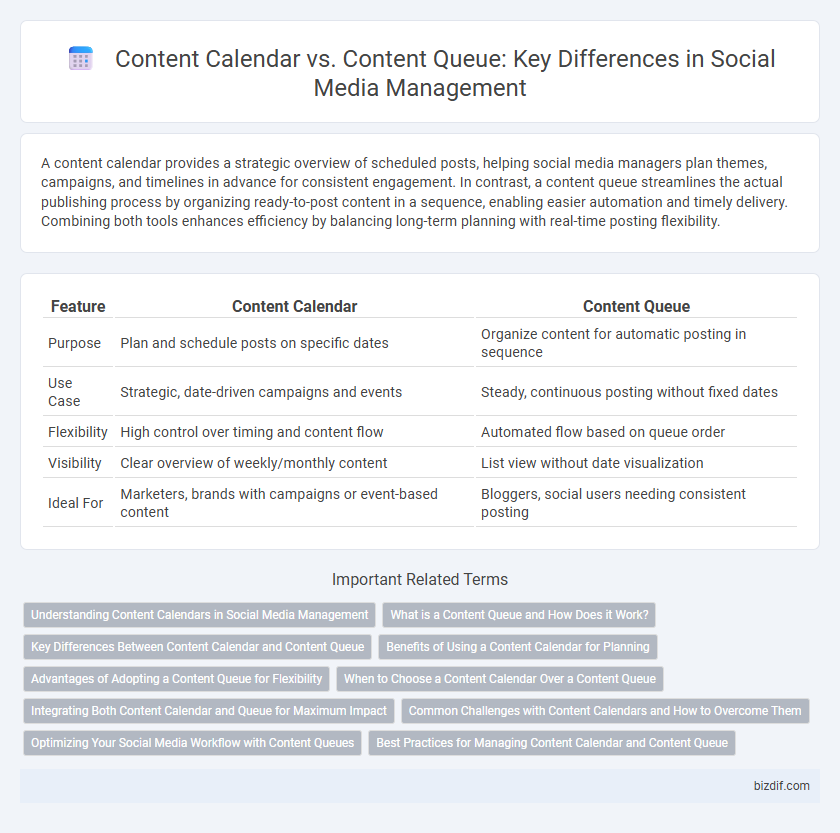A content calendar provides a strategic overview of scheduled posts, helping social media managers plan themes, campaigns, and timelines in advance for consistent engagement. In contrast, a content queue streamlines the actual publishing process by organizing ready-to-post content in a sequence, enabling easier automation and timely delivery. Combining both tools enhances efficiency by balancing long-term planning with real-time posting flexibility.
Table of Comparison
| Feature | Content Calendar | Content Queue |
|---|---|---|
| Purpose | Plan and schedule posts on specific dates | Organize content for automatic posting in sequence |
| Use Case | Strategic, date-driven campaigns and events | Steady, continuous posting without fixed dates |
| Flexibility | High control over timing and content flow | Automated flow based on queue order |
| Visibility | Clear overview of weekly/monthly content | List view without date visualization |
| Ideal For | Marketers, brands with campaigns or event-based content | Bloggers, social users needing consistent posting |
Understanding Content Calendars in Social Media Management
Content calendars in social media management provide a strategic overview for scheduling and organizing posts according to specific dates, events, or campaigns, enabling consistent and timely content delivery. Unlike content queues that focus on a dynamic list of upcoming posts, content calendars offer a visual timeline that helps in planning themes, tracking deadlines, and aligning content with marketing objectives. Utilizing a well-structured content calendar improves workflow efficiency, ensures content variety, and supports data-driven decision-making to optimize audience engagement.
What is a Content Queue and How Does it Work?
A content queue is a scheduled lineup of pre-approved social media posts organized to publish automatically according to predetermined times, ensuring consistent engagement. Unlike a content calendar that maps out when and what to post, a content queue streamlines execution by continuously filling slots with evergreen or timely content. This system optimizes workflow efficiency, maintains steady audience interaction, and helps social media managers avoid last-minute content gaps.
Key Differences Between Content Calendar and Content Queue
A content calendar organizes scheduled posts with specific dates and times, enabling strategic planning and consistent publishing across platforms. In contrast, a content queue is a dynamic, prioritized list of ready-to-publish content that allows for flexible, real-time posting without fixed deadlines. The key differences lie in the calendar's structured timeline for long-term planning versus the queue's adaptive sequence for immediate content distribution.
Benefits of Using a Content Calendar for Planning
A content calendar enhances social media management by providing a structured timeline that aligns posts with marketing goals, key events, and audience engagement patterns. It improves team collaboration by clearly outlining deadlines and responsibilities, reducing the risk of last-minute content production. This strategic approach increases consistency in posting frequency, which boosts brand visibility and audience trust across platforms.
Advantages of Adopting a Content Queue for Flexibility
A content queue offers enhanced flexibility in social media management by allowing posts to be easily reordered, rescheduled, or paused without disrupting the overall strategy. Unlike a rigid content calendar, a queue adapts quickly to real-time trends and audience engagement, optimizing timing and relevance. This dynamic approach streamlines workflow and ensures consistent content delivery aligned with brand goals.
When to Choose a Content Calendar Over a Content Queue
Choose a content calendar over a content queue when strategic planning and consistency are critical for social media campaigns, as calendars provide a clear, visual schedule of posts arranged by date and time. Content calendars optimize collaboration among marketing teams, enabling alignment with key events, holidays, and product launches for comprehensive campaign execution. This approach is essential for brands aiming to maintain long-term engagement and monitor content performance systematically across multiple platforms.
Integrating Both Content Calendar and Queue for Maximum Impact
Integrating a content calendar with a content queue streamlines social media management by scheduling posts for optimal timing while maintaining flexibility for last-minute updates. A content calendar organizes planned content around key dates and campaigns, ensuring strategic consistency, whereas a content queue allows for dynamic adjustment based on real-time audience engagement and trends. This combined approach maximizes reach, engagement, and efficiency by balancing long-term planning with agile content deployment.
Common Challenges with Content Calendars and How to Overcome Them
Content calendars often face challenges such as inflexibility, difficulty accommodating last-minute changes, and time-consuming updates, which can hinder agile social media management. Overcoming these obstacles involves integrating dynamic scheduling tools that allow real-time adjustments and leveraging content queues for automated, continuous posting. Utilizing analytics to forecast engagement trends further optimizes posting schedules while maintaining strategic alignment with marketing goals.
Optimizing Your Social Media Workflow with Content Queues
Content queues streamline social media workflow by automating post scheduling based on predefined categories and optimal posting times, reducing manual effort compared to traditional content calendars. By using content queues, brands can maintain consistent output, improve engagement through timely publication, and easily adjust priorities without disrupting the overall strategy. This approach enhances efficiency, allowing social media managers to focus on content quality rather than constant scheduling.
Best Practices for Managing Content Calendar and Content Queue
Effective social media management requires a balanced approach to content calendars and content queues, ensuring consistent posting while maintaining flexibility for timely updates. Best practices include scheduling content in advance using a content calendar to align with marketing goals and seasonal trends, while managing a content queue allows for dynamic adjustments and real-time engagement. Leveraging analytics tools to monitor performance enables optimization of both planned and queued posts for maximum audience impact.
content calendar vs content queue Infographic

 bizdif.com
bizdif.com